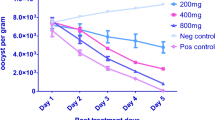Abstract
Coccidian organisms of poultry have proved very hard to control due to their abilities to resist most anticoccidial drugs. Pleurotus ostreatus (Fr.) Jacq. ex (Pleurotaceae), a medicinal mushroom, was investigated in vivo against Eimeria spp. Ninety-six broilers (day-old) naturally infected with Eimeria spp. were divided into eight groups (12 birds per group). Group A was infected untreated (negative control) and group B was treated with toltrazuril (positive control) while groups C–H were gavaged with graded doses of P. ostreatus extract at 100, 200, 300, 400, 500, and 600 mg/kg, respectively. The phytochemical analysis of the aqueous extract of P. ostreatus which revealed saponins, flavonoids, anthraquinones, and alkaloids was evaluated for anticoccidial activity by assessing the inhibition of oocyst output, lesion score, faecal score, weight differences, haematological parameters, and leucocyte differential counts. The acute toxicity study showed extract of P. ostreatus to be non-toxic at 600 mg/kg. The weight of the groups treated with the extracts and toltrazuril increased significantly (P < 0.05) compared with the untreated control. Treated groups significantly (P < 0.05) reduced oocyst output except groups C and D. The therapeutic best-fit ED50 value for the extract was 448 mg/kg. The post-treatment mean packed cell volume and red blood cell count were significantly higher (P < 0.05) than the untreated group, while the WBC count was significantly higher (P < 0.05) in the untreated group. Pleurotus ostreatus therefore could be a potential source of new anticoccidial medicine which could find application in the control of avian coccidiosis.





Similar content being viewed by others
References
Abbas, R.Z., Iqbal, Z., Blake, D., Khan, M.N. & Saleemi, M.K. (2011). Anticoccidial drug resistance in fowl coccidia: the state of play revisited. World’s Poultry Science Journal, 67, 337–350.
Abbas, R.Z., Colwell, D.D. & Gilleard, J. (2012). Botanicals: an alternative approach for the control of avian coccidiosis. World's Poultry Science Journal, 68, 203–215.
Ademola, I.O. & Odeniran, P.O. (2016). Novel trypanocide from an extract of Pleurotus sajor-caju against Trypanosoma congolense. Pharmaceutical Biology, 55(1), 132–138.
Allen, P.C., Danforth, H.D. & Augustine, P.C. (1998). Dietary modulation of avian coccidiosis. International Journal of Parasitology, 28, 1131–1140.
Borchers, A.T., Stern, J.S., Hackman, R.M., Keen, C.L. & Gershwin, M.E. (1999). Mushrooms, tumors, and immunity. Proceedings of the Society for Experimental Biological Medicine, 221, 281–293.
Chapman, H.D. (2000). Practical use of vaccines for the control of coccidiosis in the chicken. World's Poultry Science Journal, 56, 7–20.
Eloff, J.N. (1998). Which extract should be used for the screening and isolation of antimicrobial components from plants. Journal of Ethnopharmacology, 60, 1–8.
Estrada, A., Yun, C.H., Andrew, V.K., Bing, L., Shirley, H. & Bernard, L. (1997). Immunomodulatory Activities of Oat β-glucan In vitro and In vivo. Microbiology and Immunology, 41, 991–998.
Ghafoor, A., Badar, H., Hussain, N. & Tariq, N. (2010). An empirical estimation of the factors affecting demand and supply of poultry meat. Pakistan Veterinary Journal, 30, 172–174.
González-Palma, I., Escalona-Buendía, H.B., Ponce-Alquicira, E., Téllez-Téllez, M., Gupta, V. K., Díaz-Godínez, G. & Soriano-Santos, J. (2016). Evaluation of the antioxidant activity of aqueous and methanol extracts of Pleurotus ostreatus in different growth stages. Frontiers in Microbiology, 12, 1–9.
Hafez, H.M. (2011). Enteric Diseases of Poultry with Special Attention to Clostridium perfringens. Pakistan Veterinary Journal, 31, 175–184.
Iwalokun, B.A., Usen, U.A., Otunba, A.A. & Olukoya, D.K. (2007). Comparative phytochemical evaluation, antimicrobial and antioxidant properties of Pleurotus ostreatus. African Journal of Biotechology, 6(15), 1732–1739.
Jain, N.C. (1986). Schalm’s veterinary hematology. 4th ed. Philadelphia (PA): Lea and Febiger. p. 610–612.
Johnson, J. & Reid, W.M. (1970). Anticoccidial drugs: Lesion scoring techniques in battery and floor-pen experiments with chickens. Experimental Parasitology, 28, 30–36.
Jung, W., Chun-Nam, C., Yeo-Eun, L., Chang-Yeol, Y., Eun-Kee, P., Suk, K. & Hu-Jang, L. (2011). Anti-diarrheal effects of a combination of Korean traditional herbal extracts and dioctahedralsmectite on piglet diarrhea caused by Escherichia coli and Salmonella typhimurium. Pakistan Veterinary Journal, 31, 336–340.
Koinarski, V., Georgieva, N., Gadjeva, V. & Petkov, P. (2005). Antioxidant status of broiler chickens infected with Eimeria acervulina. Revue de Medecine Veterinaire 156, 498–502.
Sanjay, P., Kartik, D.V., Pithawala, E.A., Shukla, M.D., Lahiri, S.K., Jain, N.K. & Modi, H.A. (2015). Phytochemical screening, total phenolic content, antimicrobial and antioxidant activity of wild edible mushroom Pleurotus ostreatus. International Research Journal of Pharmacy, 6(1), 65–69.
Seifert, H. (2006). Tropical Animal Health. Kluwee academic Publishers, Boston. 57.
Selegean, M., Putz, M.V. and Rugea, T. (2009). Effect of polysaccharide extract from the edible mushroom Pleurotus ostreatus against infections bursal disease virus. International Journal Molecular Science, 10, 3616–3634.
Shirley, M.W. & Lillehoj, H.S. (2012). The long view: a selective review of 40 years of coccidiosis research. Avian Pathology, 41, 111–121.
Vassilev, D.G. (2002). Special modification of McMaster. In: B. Cumming (ed). Manual of veterinary parasitological techniques (Central Veterinary Laboratory, London).
Wandati, T.W., Kenji, G.M. & Onguso, J.M. (2013). Phtochemicals in edible wild mushrooms from selected areas in Kenya. Journal of Food Research, 2(3), 137–144.
Youn, H.J. & Noh, J.W. (2001). Screening of the anticoccidial effects of herb extracts against Eimeria tenella. Veterinary Parasitology, 96, 257–263.
Zaman, M.A., Iqbal, Z., Abbas, R.Z. & Khan, M.N. (2011). Anticoccidial activity of herbal complex in broiler chickens challenged with Eimeria tenella. Parasitology, 139, 237–243.
Author information
Authors and Affiliations
Corresponding author
Ethics declarations
Conflict of interest
The authors declare that they have no conflicts of interest.
Rights and permissions
About this article
Cite this article
Ademola, I.O., Ojo, P.O. & Odeniran, P.O. Pleurotus ostreatus extract inhibits Eimeria species development in naturally infected broiler chickens. Trop Anim Health Prod 51, 109–117 (2019). https://doi.org/10.1007/s11250-018-1665-9
Received:
Accepted:
Published:
Issue Date:
DOI: https://doi.org/10.1007/s11250-018-1665-9




